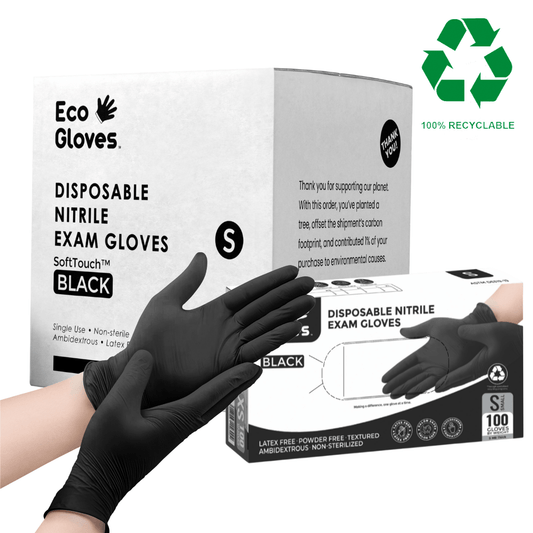PE vs CPE vs Compostable Gloves
Eco Gloves


Wearing disposable gloves in the workplace is important to ensure the safety of both workers and the general public. Gloves help to prevent the spread of harmful bacteria, viruses, and other contaminants that can cause serious illnesses and infections. They also protect workers from hazardous chemicals, biological fluids, and other hazardous materials that they may come into contact with on the job.
Polyethylene Gloves (PE)
Polyethylene gloves, also known as PE gloves, are made from low-density polyethylene (derived from oil or petroleum resources) and are the most commonly used type of synthetic gloves. Polyethylene gloves are a cost-effective and versatile option for various applications, including handling chemicals, dipping hands into liquids, cleaning, food handling, and medical uses. These gloves are made from a strong and durable plastic that is resistant to oils and solvents. Their non-conductive properties and low elasticity make them easy to remove without breaking the seal. However, they provide limited protection against cuts and should not be used in excessively hot environments. Additionally, polyethylene gloves are designed for single-use only and are not suitable for heavy tasks due to their low strength. While they are suitable for use in both cold and warm temperatures, they are not meant for long-term use and cannot be reused. PE gloves are affordable and widely available, but they are not biodegradable and their heavy petroleum-based material make them an unsustainable option.Polyethylene is a synthetic plastic polymer that is produced from petrochemicals. After use, polyethylene gloves are typically discarded as waste, which can contribute to environmental pollution and harm wildlife and their habitats. In addition, polyethylene does not break down naturally and can persist in the environment for hundreds of years, leading to the buildup of plastic waste in landfills and oceans. The production of polyethylene also contributes to greenhouse gas emissions and the depletion of non-renewable petroleum resources. These factors make polyethylene gloves an unsustainable and environmentally harmful option.
Chlorinated Polyethylene Gloves (CPE)
Chlorinated Polyethylene gloves, also known as CPE gloves, are made from a special type of polyethylene that has been treated with chlorine. This makes them more resistant to oils, making them ideal for handling extremely corrosive substances. Like polyethylene gloves, CPE gloves are non-conductive, have low elasticity, and are affordable. However, they are not recommended for food handling or medical settings with strict cleanliness standards. CPE gloves may contain residual chlorine, which is not considered safe for direct contact with food. In addition, CPE gloves are not as hygienic as other materials used for food handling and may pose a contamination risk. It is recommended to use gloves made of materials specifically approved for food contact, such as polyethylene, compostable, vinyl or nitrile gloves, in food handling applications. While CPE gloves provide good protection against cuts and are suitable for heavy tasks, CPE gloves are not suitable for use in cold environments and should not be used with highly corrosive chemicals. It is important to replace them if they become heavily contaminated, as they are intended for single-use only. This type of glove is cheaper and stronger than PE gloves, but it also has a negative impact on the environment and is not biodegradable.Like other plastic products, CPE material can persist in the environment for hundreds of years. This can harm wildlife and their habitats, as well as contribute to the buildup of plastic waste in landfills and oceans. Additionally, the production of CPE gloves, as well as their transportation and disposal, consumes energy and resources, contributing to greenhouse gas emissions and the depletion of natural resources.
Thermoplastic Elastomer Gloves (TPE)
Thermoplastic Elastomer gloves, also known as TPE gloves, are made from a combination of thermoplastic and elastomers, giving them a rubber-like feel and making them resistant to a wide range of chemicals, acids, and bases. TPE gloves can withstand high temperatures of up to 350 degrees Fahrenheit. They are a versatile choice for many applications, including food handling and medical use, as well as both cold and warm environments. However, they may not provide adequate protection against cuts. Although TPE gloves are not suitable for extreme heat, they are a strong and economical option, suitable for both light and heavy tasks, as they have high elasticity and are non-conductive. Additionally, TPE gloves are washable and reusable, making them a more sustainable option for long-term use compared to disposable gloves.While TPE gloves provide good protection, they also can have a negative environmental impacts like their plastic counterparts. Similarly, they are non-biodegradable and can persist in the environment for hundreds of years. The production of TPE also consumes a lot of energy and natural resources, while generating harmful greenhouse gas emissions, which can contribute to climate change. Moreover, the disposal of TPE gloves in landfills can lead to the release of harmful chemicals into the environment, as TPE gloves can leach toxic chemicals over time.
Compostable Gloves
Compostable gloves are made from plant-based materials and are designed to biodegrade in a composting environment. This type of glove provides the same level of protection as traditional synthetic gloves, but they are much better for the environment.
Compostable gloves can be used in a variety of applications, including food handling, medical care, cleaning, and any other situation where disposable gloves are needed. They are made from biodegradable materials, such as starch, corn, or sugarcane, and are designed to break down and return to the soil when exposed to the elements in a composting environment.
Compostable gloves offer a more sustainable alternative to traditional synthetic plastic gloves, as they are biodegradable and do not contribute to plastic pollution. They also have similar functionalities and are comparable in terms of strength and durability, making them a suitable choice for many applications.
It is important to note that compostable gloves may not perform as well as synthetic plastic gloves in harsh environments, such as extreme heat or corrosive chemicals. It is also important to ensure that compostable gloves are disposed of properly, in a composting environment, to allow for maximum biodegradation and to minimize any negative impact on the environment.
What's the difference between PE, CPE, TPE, and Compostable Gloves?
The difference between PE, CPE, TPE, and Compostable gloves lies in the material they are made of and the level of protection they provide. To put it simply, PE, CPE, and TPE all are made of plastic and petroleum-derived materials. PE gloves, made from plastic, are the most known type of disposable gloves, particularly for food handling. CPE gloves, made with added chlorine for increased chemical resistance, offer more protection against cuts compared to PE gloves. TPE gloves, made from synthetic rubber, are latex-free, but provide the least protection against cuts among the four. Compostable gloves, made from plant-based materials and accelerated compostable agents, provide the same level of protection, strength, elasticity and durability as the synthetic types of plastic gloves, but are also a better environment-friendly alternative to the rest.
Which Glove Should You Choose?
When selecting gloves for your work environment, it's important to consider the type of tasks you'll be performing, the level of protection needed, the gloves' expected lifespan, and the impact they have on the environment. CPE gloves offer better protection against corrosive chemicals than PE gloves, but they may not be necessary for less severe conditions. PE gloves can provide adequate protection in those instances. However, it's important to note that all synthetic plastic gloves, including PE and CPE, have a negative impact on the environment and contribute to the growing issue of plastic waste. In such cases, a more sustainable option would be compostable gloves, which are made from biodegradable materials and break down naturally in the environment, minimizing their impact on the planet.
Conclusion
When it comes to hand protection, there is no one-size-fits-all solution. Each type of glove, whether PE, CPE, TPE, or Compostable has its own strengths and weaknesses. To ensure optimal safety, it is best to use a combination of gloves that offer protection against a range of hazards, and that might even include expanding into latex, vinyl, or nitrile gloves. While PE, CPE, and TPE gloves all have their benefits, a more sustainable and environmentally-friendly option would be to use compostable gloves. Compostable gloves are a responsible and sustainable alternative to synthetic gloves and are a critical tool in the fight against plastic waste. By choosing Compostable gloves you can keep your hands protected while also reducing your impact on the environment.
If you’re looking for good quality, thick and durable food handling gloves, Eco Gloves is here to help.
Check out our products and see which best suits your needs. Whether you’re looking to safe time and money on purchasing by subscription or in bulk, we’ve got the best deals for you.
Got questions or need assistance? Feel free to hit us up through this form. We’d love to hear from you!
Got questions or need assistance? Contact us here. We'd love to hear from you!
Key Takeaways: Choosing the Right Disposable Gloves for Food Handling
-
Different Materials, Different Benefits: PE, CPE, TPE, and compostable gloves each have unique strengths, from chemical resistance to reusability.
-
PE Gloves – Affordable & Versatile: Common in food handling, these gloves are lightweight and cost-effective but not biodegradable.
-
CPE Gloves – Enhanced Chemical Resistance: Treated with chlorine for improved oil and chemical resistance, but not food-safe in all cases.
-
TPE Gloves – Flexible & Reusable: Rubber-like feel with good elasticity, suitable for food handling and reusable for light to moderate tasks.
-
Compostable Gloves – Eco-Friendly Alternative: Made from plant-based materials, they break down in composting environments while offering similar strength and durability as plastic gloves.
-
Sustainability Matters: PE, CPE, and TPE are petroleum-based and non-biodegradable; compostable gloves reduce long-term environmental impact.
👉 Whether you prioritize cost, durability, or sustainability, Eco Gloves offers a full range of options, including compostable gloves, to meet your food safety needs without compromising on environmental responsibility.
Frequently Asked Questions About Disposable Gloves for Food Handling
-
What are PE gloves best used for?
PE gloves are ideal for light-duty food handling tasks and general protection needs. They are affordable but not biodegradable.
-
Are CPE gloves safe for food contact?
Not always. While they offer strong chemical resistance, some CPE gloves may contain residual chlorine, making them unsuitable for direct food contact unless food-safe certified.
-
How are TPE gloves different from PE gloves?
TPE gloves have a rubber-like feel, greater elasticity, and can be reused for certain light to moderate tasks, while PE gloves are thinner and designed for single use.
-
Why choose compostable gloves over plastic gloves?
Compostable gloves provide the same protection and durability as traditional plastic gloves but are made from plant-based materials that break down in composting environments, reducing waste.
-
Can compostable gloves handle extreme conditions?
Compostable gloves work well for general food handling but may not perform as well in extreme heat, with highly corrosive chemicals, or in industrial environments.
-
Which glove type is most environmentally friendly?
Compostable gloves are the most eco-friendly choice, as they naturally break down and help reduce plastic pollution.


















